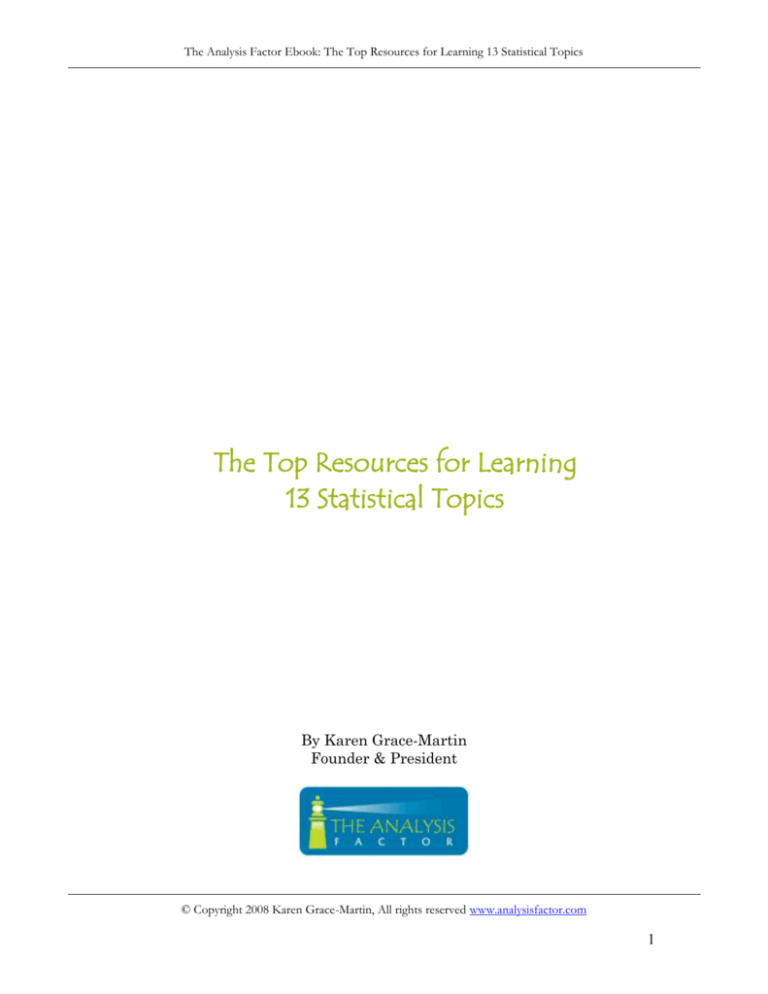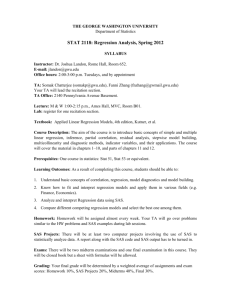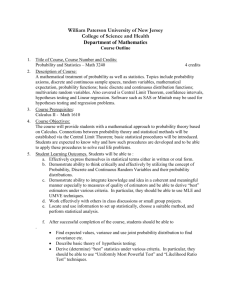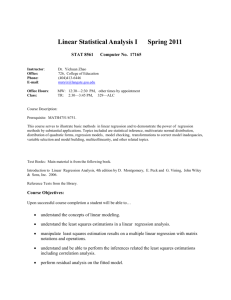
The Analysis Factor Ebook: The Top Resources for Learning 13 Statistical Topics
The Top Resources for Learning
13 Statistical Topics
By Karen Grace-Martin
Founder & President
© Copyright 2008 Karen Grace-Martin, All rights reserved www.analysisfactor.com
1
The Analysis Factor Ebook: The Top Resources for Learning 13 Statistical Topics
About the Author
Karen Grace-Martin is the founder and president of The
Analysis Factor. She is a professional statistical consultant
with Masters degrees in both applied statistics and social
psychology. Her career started in psychology research, where
her frustration in applying statistics to her data led her to
take more and more statistics classes. She soon realized that
her favorite part of research was data analysis, leading to a
career change. Her background in experimental research and
working with real data has been invaluable in understanding the challenges
that researchers face in using statistics and has spurred her passion for
deciphering statistics for academic researchers.
Karen was a professional statistical consultant at Cornell University for
seven years before founding The Analysis Factor. Karen has worked with
clients from undergraduate honors students on their first research project to
tenured Ivy League professors, as well as non-profits and businesses. Her
ability to understand what researchers need and to explain technical
information at the level of the researcher’s understanding has been one of her
strongest assets as a consultant. She treats all clients with respect, and
derives genuine satisfaction from the relief she hears in their voices when
they realize that someone can help them.
Before consulting, Karen taught statistics courses for economics, psychology,
and sociology majors at the University of California, Santa Barbara and
Santa Barbara City College. Karen has also developed and presented many
statistics workshops, most recently on missing data, logistic regression, and
interpreting regression parameters.
Karen has co-written an introductory statistics textbook with sociologist
Stephen Sweet: Data Analysis with SPSS. It focuses on statistical concepts
and data analysis practices, without the endless calculations that often
obscure them.
© Copyright 2008 Karen Grace-Martin, All rights reserved www.analysisfactor.com
2
The Analysis Factor Ebook: The Top Resources for Learning 13 Statistical Topics
Introduction
I have devoted my entire professional life to excellence in research and data
analysis in academic settings. My passion is in helping academic researchers
learn, apply, and practice statistics without the frustration that so often
comes with it.
One role I have that is of great help to researchers is recommending good
resources. Let’s face it—there is a whole lot of information out there about
statistics, and much of it is incomprehensible. But there are gems in the
rough. This paper is a collection of the best resources I can recommend to
researchers who need to learn a new topic in statistics.
I assume you do have a good basic statistical base—these won’t be helpful for
newbies. You need to have a good conceptual understanding of hypothesis
testing, general statistical concepts, and be relatively comfortable performing
a multiple regression or factorial ANOVA.
Most academic researchers I work with are at this level, but now need to go
beyond it without taking more statistics classes. These resources will help
you learn and apply statistical methods that are at one level beyond the
general linear model.
I have chosen the resources that I believe are most helpful for learning that
topic. These lists are not exhaustive—you can find many more resources at
http://analysisfactor.com/resources/resources.html and at my blog:
http://www.analysisfactor.com/statchat. Here I’ve picked the best resources
for each one. These are the ones I would start with if I were learning or
needing to refresh my understanding of a topic.
That said, they are chosen for their readability as well. I don’t believe that
being adept at regression requires you understand linear algebra or means
you find it helpful to see equations or statistical theory derived. When
possible, I have chosen non-technical sources. That doesn’t mean some won’t
be a stretch. Read it twice, or even three times. Try out the method, then
read it again.
Some topics have more resources listed than others. Some topics need only
one, some topics have only one. But the list in each topic should be enough to
get you started doing that method well.
© Copyright 2008 Karen Grace-Martin, All rights reserved www.analysisfactor.com
3
The Analysis Factor Ebook: The Top Resources for Learning 13 Statistical Topics
I am always interested in hearing about other good resources for learning
and applying statistics, so if you know of any, send me an email please. I
consider this ebook a work in progress!
Table of Contents
Complex Surveys
Factor Analysis
Logistic Regression
Missing Data
Mixed ANOVA Models
Multilevel Regression Models
Nonparametric Statistics
Path Analysis
Poisson & Negative Binomial Regression
Principal Components Analysis
Sample Size Calculations
Structural Equation Modeling
Survival and Event History Analysis
Tobit Regression
5
5
5
6
7
7
8
8
8
9
9
9
10
10
© Copyright 2008 Karen Grace-Martin, All rights reserved www.analysisfactor.com
4
The Analysis Factor Ebook: The Top Resources for Learning 13 Statistical Topics
Complex Surveys
Pitfalls of Using Standard Statistical Software Packages for Sample
Survey Data.
by Donna J. Brogan
Analysing Complex Survey Data: Clustering, Stratification and
Weights
by Patrick Sturgis
Summary of Survey Analysis Software
By Harvard University Survey Research Methods Section
http://www.hcp.med.harvard.edu/statistics/survey-soft/
Factor Analysis
An Explanation of Factor Analysis
by Richard Darlington, Cornell University
http://comp9.psych.cornell.edu/Darlington/factor.htm
A Step-by-Step Approach to Using the SAS System for Factor
Analysis and Structural Equation Modeling
by Larry Hatcher
This is THE book to read if you’re doing Factor Analysis. The first chapter
alone on Principal components is amazing. Very well written and
nontechnical. Even if you don’t use SAS, this book explains Factor Analysis
VERY well. Just ignore the SAS code.
Logistic Regression
DeMaris, Alfred. (1995) A Tutorial in Logistic Regression. Journal of
Marriage and the Family, 57, 956-968.
Morgan, Philip S., Teachman, Jay D. (1988) Logistic Regression:
Description, Examples, and Comparisons. Journal of Marriage and the
Family, 50, 929-936.
© Copyright 2008 Karen Grace-Martin, All rights reserved www.analysisfactor.com
5
The Analysis Factor Ebook: The Top Resources for Learning 13 Statistical Topics
Logistic Regression Using the SAS System : Theory and Application
by Paul Allison
You’ve probably noticed by now that I really like Paul Allison’s books.
He is one of my favorite applied statistics authors. This one is great as
well.
Applied Logistic Regression Analysis
by Scott Menard
A great introduction to logistic regression, and very reasonably priced.
I love all of the books in this series that I’ve read. Contains enough
statistical theory to be helpful, but not lots of technical jargon or
deriving equations. Readers should be quite familiar with linear
regression.
Missing Data
Allison, Paul (2000). Multiple Imputation for Missing Data: A
Cautionary Tale. Sociological Methods and Research, 28, 301-309.
Schafer, J.L. & Graham, J.W. (2002). Missing Data: Our View of the State
of the Art, Psychological Methods, 7, 147-177.
Missing Data
by Paul Allison
Very reader-friendly. One of “the little green Sage books.” This is an
excellent overview, covers much of what a data analyst needs to know,
and very accessible. This is the book to start with. And very
reasonably priced.
http://multiple-imputation.com
© Copyright 2008 Karen Grace-Martin, All rights reserved www.analysisfactor.com
6
The Analysis Factor Ebook: The Top Resources for Learning 13 Statistical Topics
Mixed ANOVA Models
SAS for Mixed Models, Second Edition
by Ramon Littell, George Miliken, Walter Stroup, Russell Wolfinger, & Oliver
Schabenberger
This is a pretty technical book, and is not for the statistically feeble.
That said, if you are doing Mixed Modeling in SAS, it’s a must-have.
Back in the Cornell Statistical Consulting office, we actually wore ours
out.
Mixed Up Mixed Models: Things That Look Like They Should Work
But Don’t And Things That Look Like They Shouldn’t Work But Do
By Robert Hamer & P.M. Simpson
http://www2.sas.com/proceedings/sugi25/25/aa/25p020.pdf
Multilevel Regression Models
Arnold, Carolyn L. (1992). An Introduction to Hierarchical Linear
Models. Measurement and Evaluation in Counseling and Development, 25,
58-90.
Plewis, Ian. (1998) Multilevel Models. Social Research Update, 23.
http://sru.soc.surrey.ac.uk/SRU23.html
Singer, Judith D. (1998) Using SAS PROC MIXED to Fit Multilevel
Models, Hierarchial Models, and Individual Growth Models. Journal
of Educational and Behavioral Statistics, 24, 323-355.
http://gseweb.harvard.edu/~faculty/singer/Papers/Using%20Proc%20Mixed.p
df
This article uses SAS, but the ATS group at UCLA has on their web
site papers that go through the examples in HLM, MLwiN, Stata,
SPSS, and SPLUS.
http://www.ats.ucla.edu/stat/paperexamples/singer/default.htm
© Copyright 2008 Karen Grace-Martin, All rights reserved www.analysisfactor.com
7
The Analysis Factor Ebook: The Top Resources for Learning 13 Statistical Topics
SAS for Mixed Models, Second Edition
by Ramon Littell, George Miliken, Walter Stroup, Russell Wolfinger, & Oliver
Schabenberger
This is a pretty technical book, and is not for the statistically feeble.
That said, if you are doing Mixed Modeling in SAS, it’s a must-have.
Back in the Cornell Statistical Consulting office, we actually wore ours
out.
Nonparametric Statistics
StatXact 3 for Windows: Statistical Software for Exact
Nonparametric Inference, Quick Reference Guide
There are quite a few books on nonparametric statistics, and they’re
not necessarily difficult, but this book is the best. It is actually a
software manual for StatXact, which does exact p-value calculations on
a huge number of non-parametric statistics. It has, however,
amazingly clear explanations on just about every nonparametric test
you’d ever want to do.
Path Analysis
Baron, Reuben M. & Kenny, David A. The Moderator-Mediator Variable
Distinction in Social Psychological Research: Conceptual, Strategic,
and Statistical Considerations. Journal of Personality and Social
Psychology, 51, 1173-1182
Poisson & Negative Binomial Regression
Gardener,W., Mulvey, E.P., Shaw, E.C. (1995) Regression Analyses of
Counts and Rates: Poisson, Overdispersed Poisson, and Negative
Binomial Models. Psychological Bulletin.
Long, J.S. (1997) Regression Models for Categorized and Limited
Dependent Variables. Thousand Oaks, CA: Sage Publications.
Long, J. Scott & Freese, Jeremy. (2006). Regression Models for
Categorical Dependent Variables Using Stata, Stata Press.
© Copyright 2008 Karen Grace-Martin, All rights reserved www.analysisfactor.com
8
The Analysis Factor Ebook: The Top Resources for Learning 13 Statistical Topics
Principal Components Analysis
Chapter 1 of: A Step-by-Step Approach to Using the SAS System for
Factor Analysis and Structural Equation Modeling
by Larry Hatcher
This is by far the best explanation of Principal Components Analysis
(with step-by-step instructions) I’ve seen, even if you don’t use SAS.
StatNews 49: Prinicipal Components: Not Just Another Factor
Analysis
By Yun Wang
http://cscu.cornell.edu/news/statnews/stnews49.pdf
Sample Size Calculations
Hoenig, John M. and Heisey, Dennis M. (2001), ``The Abuse of Power: The
Pervasive Fallacy of Power Calculations for Data Analysis,'' The
American Statistician, 55, 19-24.
Lenth, R. V. (2001), Some Practical Guidelines for Effective Sample
Size Determination,' The American Statistician, 55, 187-193.
Lenth, R. V. (2002). Two Sample Size Practices that I don’t
Recommend, Presented at the Joint Statistical Meetings.
Structural Equation Modeling
Ed Rigdon's SEM FAQ
Structural Equations with Latent Variables
By Kenneth Bollen
This is dry, and not light reading, but it is the definitive text.
© Copyright 2008 Karen Grace-Martin, All rights reserved www.analysisfactor.com
9
The Analysis Factor Ebook: The Top Resources for Learning 13 Statistical Topics
Survival and Event History Analysis
Singer, J.D. & Willet, J.B. (1993). It's About Time: Using Discrete-Time
Survival Analysis to Study Duration and the Timing of Events.
Journal of Educational Statistics, 18, 155-195.
Event History Analysis: Regression for Longitudinal Event Data
By Paul Allison
Survival Analysis Using SAS: A Practical Guide
by Paul Allison
This book alone will teach you just about everything you need to know about
Survival Analysis. It’s worthwhile, even if you don’t use SAS.
Tobit Regression
Regression Models: Censored, Sample Selected, or Truncated Data
by Richard Breen
This is a pretty specific topic, but it’s a great book when you need it. I love all
of the books in this series that I’ve read. Readers should be quite familiar
with linear regression.
© Copyright 2008 Karen Grace-Martin, All rights reserved www.analysisfactor.com
10









